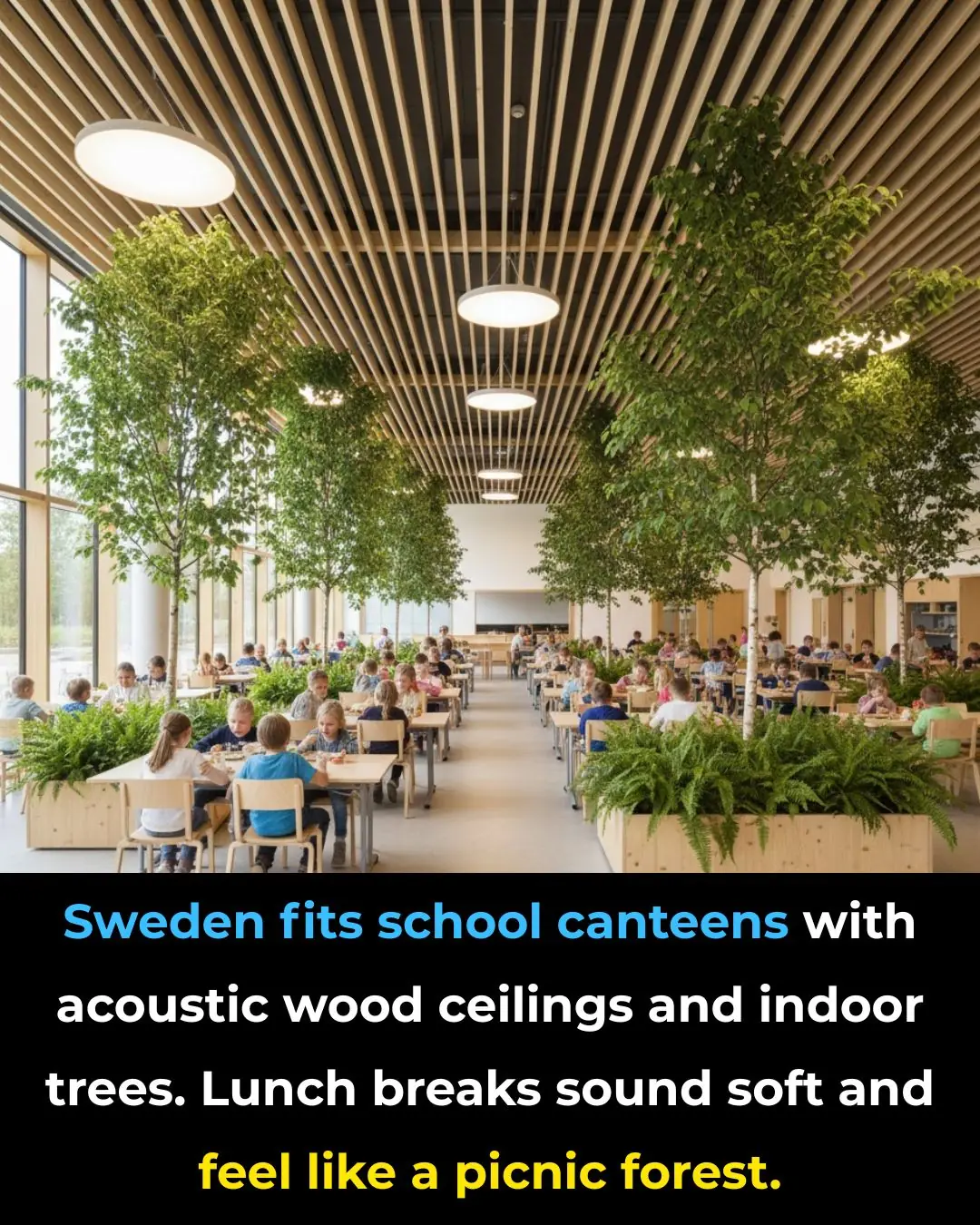
Sweden Turns School Lunchrooms Into Forest-Inspired Sanctuaries to Boost Student Well-Being

In Sweden, school dining halls are undergoing a striking transformation—shifting from utilitarian cafeterias into calming, forest-like spaces where the clatter of trays and echo of chatter gradually recede beneath natural architecture. These upgrades are part of a national push to promote student well-being by redesigning built spaces in line with biophilic and acoustic design principles. Children no longer eat in stark, sterile halls; instead they dine beneath slatted timber ceilings that absorb sound, distribute it evenly, and lower overall ambient noise levels, thereby reducing stress and promoting calmer behaviour.
Large planters with real or semi-hydroponic trees—birch, olive or small-leaved fig—have been placed about the space, bringing elements of the outdoors inside: visual texture, subtle scent and a living greenery presence. Soft pendant lights, shaped like stones or leaves, hang low among branches; the air feels cooler, the ambiance gentler, and mealtimes become less chaotic and more communal. Some schools even introduce low benches and picnic-style tables to complete the effect, encouraging more relaxed social interaction rather than hurried tray-lines.
Teachers have begun reporting fewer behavioural disruptions during lunch and smoother transitions back into class. Students describe the canteens as “relaxing like a park,” and particularly in colder months, the indoor greenery offers a welcome sense of life and continuity. The combined effect of sensory comfort (reduced noise, natural materials, plants) and biophilic design reflects Sweden’s growing conviction that learning doesn’t just happen in classrooms—it thrives wherever young minds feel calm, connected and supported by their surroundings.
This shift in school dining design is far more than aesthetic—it is emotional architecture in action: spaces intentionally shaped to influence mood, social behaviour and well-being. Indeed, research on school acoustics in Sweden found that many school dining halls exceed sound levels comparable to busy highways—creating conditions unfavourable for rest, conversation and recovery during meals. One article reported that over one quarter of 71 canteens measured had peaks around 75-80 dB, or even 95 dB, which impaired pupils’ ability to recuperate after morning lessons. acousticbulletin.com+2Götessons+2
Moreover, a recent European Commission-sponsored report on sustainable learning environments identified noise, lighting, thermal comfort and green infrastructure as critical to student health, engagement and learning outcomes. ResearchGate Sweden’s initiative to redesign cafeterias can thus be seen as part of a broader strategy to promote healthy, supportive school environments.
Another relevant Swedish project involved the newly built Töjnaskolan north of Stockholm (opened in 2020/21), where natural materials and acoustic wood-slatted walls and ceilings were chosen to create warm, calm interiors. The dining hall there features timber acoustic panels and subdued natural hues, with design explicitly targeting student well-being. troldtekt.be
In practical terms, the redesigned lunch spaces provide multiple benefits:
-
Acoustic comfort: Timber panels and angled slats reduce reverberation and diffuse sound, lowering peak noise levels and improving speech intelligibility.
-
Biophilic engagement: Trees and plants help bring the outdoors inside, which has been shown to reduce stress and promote positive mood.
-
Social ease: Furniture arrangements encourage informal socialisation, rather than the rigid rows of trays found in conventional canteens.
-
Behavioural ripple-effects: calmer lunch produces smoother transitions back to class, fewer disruptions and higher readiness to learn.
From a policy perspective, these improvements reflect Sweden’s acknowledgement of the whole-child experience: it is not enough to provide nutritious meals; the dining environment itself must promote rest, connection and psychological ease. A news article on the Swedish school meal model stressed that redesigning space is part of making students feel comfortable and free—even to choose their seating, pace and company. vietnam.vn
Nonetheless, challenges remain. Scaling such upgrades to all schools requires sustained funding, local government commitment and design capacity. Many schools still operate in older buildings with poor acoustics, inadequate lighting or lacking green features. But the early signs are promising: as more schools adopt forest-inspired dining spaces, the message is clear—architecture matters in student well-being.
In summary, Sweden’s evolving school lunchroom design shows how built environments can shift from mere functionality into supportive social spaces. By combining acoustic timber ceilings, indoor trees and relaxed furniture, schools are creating an atmosphere that feels less like a rush-hour cafeteria and more like a calm communal grove. In doing so, they implicitly recognise that well-being is integral to learning, and that when children feel calm and connected, their capacity to engage and thrive increases.
Sources:
-
“School canteens in Sweden: creating acoustical food for thought!” — Acoustic Bulletin. acousticbulletin.com
-
“Good sound absorption for students’ improved food experience” — Götessons. Götessons
-
“A healthy school with calming, coherent interiors” (Töjnaskolan, Sweden) — Troldtekt. troldtekt.be
-
“School Learning Environments for Sustainability in the EU” — European Commission. ResearchGate
-
“Sustainable school meal model in Sweden” — Vietnam.vn
News in the same category


Why We Sleep With ‘T-Rex Arms’: A Self-Soothing Posture Linked to Stress and Neurodivergence

Choose the Longest Line

France Turns Forgotten Railway Tunnels into Poetic Winter Shelters for the Unhoused

Rose Essential Oil May Boost Brain Structure: New Study Reveals Increased Gray Matter Volume

Why So Many New York Buildings Don’t Have a 13th Floor

Pouring medicated oil on garlic seems like a strange thing to do, yet it offers surprising benefits that not everyone knows about

Always Close Your Bedroom Door Before Going to Sleep

Why So Many New York Buildings Don’t Have a 13th Floor

Norway’s Living Kelp Barriers: Nature-Built Protection for a Changing Coastline

Italy’s Porous Streets: A Quiet Innovation That Lets Cities Breathe Again

How Israel Is Turning Water Pipes Into Clean Power Plants

Powerful Health Benefits of Pineapple You Should Know

🐍 What to Do If You’re Bitten by a Snake — When Help Is Far Away

Motherhood Rewires the Brain: Why Postpartum Recovery Takes Years, Not Weeks

Eating More Than One Egg a Week May Slash Alzheimer’s Risk by 47%

CRISPR Breakthrough Offers Hope for a Potential HIV Cure

Four Teens Risk Their Lives to Rescue Elderly Neighbor from Burning Home in Sapulpa
News Post

Why Lung Cancer Targets Non-Smokers: The Hidden Kitchen Culprit You Might Not Know About

“Painting the Impossible: China’s Drone Experiments Turn Cliffs into Giant Artworks”

Dropping wind oil on garlic

‘Why Did You Come to This School?’: Lawsuit Says Chicago School Let 10-Year-Old Black Girl Be Called the N‑Word, Punched, and Threatened Daily—Then Blamed Her for the Disruption

Don't boil chicken with salt and water, otherwise it will be fishy and turn red.

Take the meat from the freezer and it's hard as bricks

Your Mattress Getting Dirty and Smelly? Sprinkle This on the Surface — No Water Needed, and It’ll Look Fresh Again

Sink Trick You Should Always Do Before Vacation

My nana taught me this hack to make dusty blinds sparkle in 2 mins with 0 work

How To “Remove” All The Chemicals Out Of Store-Bought Chicken

Stadiums of Sanctuary: A Winter Refuge Beneath South Africa’s Grand Arenas

Newly Discovered Molecule Could Allow Teeth to Heal Naturally, Transforming the Future of Dentistry

If You Want Your Meat to Stay Fresh Longer, Make Sure to Do This One Extra Step Before Refrigerating

Heated Sidewalks and Cold Mornings: Iceland’s Quiet Revolution in Winter Comfort

When Pleasing Others Hurts Your Health: New Study Links People-Pleasing to Autoimmune Risk

Knives become dull and rusty after long use. Remember these 5 easy ways to clean them. No matter how rusty your knife is, it will still be shiny and sharp

Why We Sleep With ‘T-Rex Arms’: A Self-Soothing Posture Linked to Stress and Neurodivergence

Choose the Longest Line
